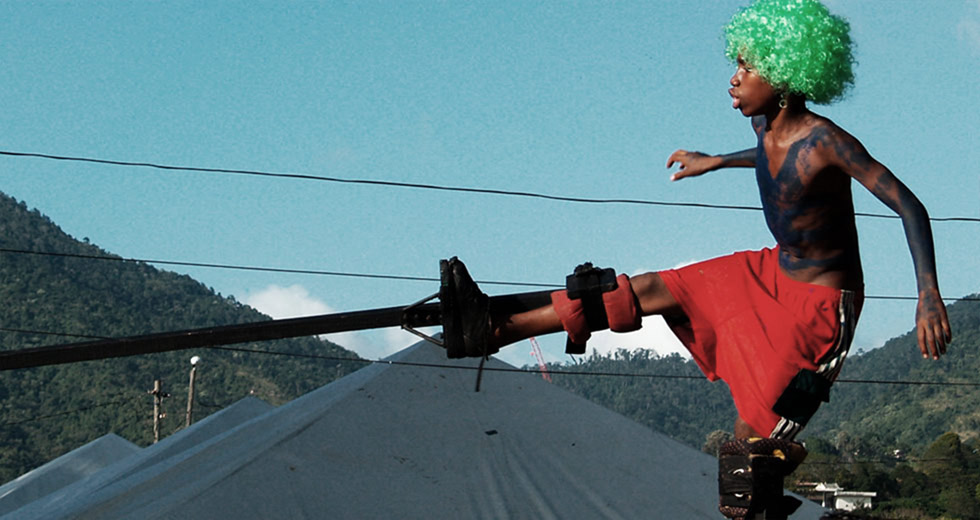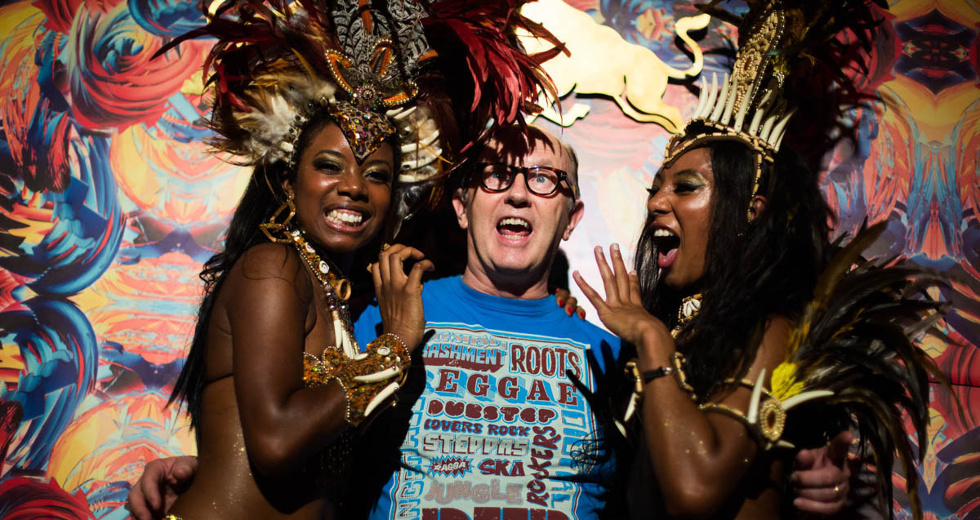Byron Lee: The Original Dragonaire
Byron Lee was one of the most important figures in the Jamaican record industry. But he was also a controversial one. David Katz explains
Byron Lee was undoubtedly one of the most important figures in the history of the Jamaican music industry. As leader of The Dragonaires, one of the island’s top show bands since the early ’60s, Lee helped build the careers of dozens of vocalists, including Jimmy Cliff, The Maytals and The Blues Busters, and was instrumental in raising the profile of ska. He later established Dynamic Sounds, then the best-equipped recording facility in the Caribbean, where excellent material was recorded by Bob Marley, The Melodians, Junior Byles and countless other Jamaican greats, as well as Paul Simon, Roberta Flack and The Rolling Stones.
As if that wasn’t enough, Lee staged Jamaican concerts with leading calypsonians and soul stars during the ’60s and ’70s, before swapping dancehall for soca in the mid-’80s, and was also instrumental in bringing Carnival celebrations to Jamaica. He received over 120 official awards for his achievements, most notably being granted the Order of Jamaica.
Yet some found Lee controversial. Many of Jamaica’s black ska originators have consistently complained that Lee appropriated their creations, angry that the Dragonaires were chosen to back the ska delegation that performed at the 1964 World’s Fair. Claims of political nepotism have been levelled, and disapproval of his penchant for MOR. Furthermore, most accounts of Jamaican music describe Lee as “Chinese” and dismiss his ability to play “authentic” Jamaican music. Similar criticism has never been directed against Mikey and Geoffrey Chung, renowned roots players of Chinese origin, nor the Hoo-Kim brothers, whose Channel One studio scored huge reggae hits in the ’70s. The Chin family of Randy’s/VP fame have also largely avoided censure.
That “Chinese” label is problematic in Lee’s case: His maternal grandmother was a woman of part-African descent, from the Jamaican village of Auchtembeddie, whose family still practiced traditional forms of African cultural expression such as Jonkunoo and Bruckins during Lee’s youth. Some point to social class as the bigger factor: Lee was definitely “uptown.” Issues of race and social class continue to be fiercely debated in Jamaica. The often privileged social status accorded minority groups with origins in Asia, Europe and the Middle East has naturally resulted in tremendous resentment, yet the complex nature of intertwined class and race elements make these issues difficult to generalise about where Jamaica is concerned.
In any case, the family moved to Kingston when Lee was eight years old and settled in the posh Mountain View Gardens district while he was still attending Mount St Joseph’s, an elite Catholic boarding school. He discovered music there through a nun’s intervention: “I used to torment the girls, so she said, ‘If you promise me that you will not hassle the girls, I will give you music lessons free,’ and that’s where I learned to play the piano. All of a sudden music became more important to me, and then, when I came to Kingston, that gave way to football.”
At St George’s College, he became a star football player, and after one successful match in 1956, Lee created an impromptu vocal group with fellow students to perform at a school victory dance. The following year, The Dragonaires officially formed with Lee as bassist and bandleader. Their recording debut, a version of Doc Bagby’s organ-and-sax instrumental, “Dumplins,” was produced by Edward Seaga at the end of the ’50s.
It was not until the Dragonaires’ appearance in the 1962 Bond film, Dr. No, that Lee felt they had made it, however. “The high point of my life was to be in the first James Bond film. I am proud of that because all the young people who watch the James Bond series can remember seeing us; it goes on forever, and the parents will tell their son or daughter, ‘I danced to that band.’”
Following the Dr. No guest spot, The Dragonaires solidified their reputation as the island’s most prominent band by staging a series of gala concerts across the island, supporting Ray Charles at the National Stadium and Ben E. King at the State Theatre. And after Seaga introduced him to ska, The Dragonaires backed many of the upcoming stars of the day. “Jimmy Cliff, Stranger & Patsy, Prince Buster, The Blues Busters, Millie Small, all these artists worked through the first couple of years of ska with us.”
I asked Lee about the charges laid against him, concerning his alleged appropriation of ska and his supposed initial dislike of the form. “Totally untrue,” he insisted. “We knew nothing about ska until Seaga sent us down there; it was being played on the western [Kingston] sound systems, but it was not played on the radio stations because they wouldn’t accept the quality: the guitars were out of tune, the records were hop, skip and jump, so when I made ‘Dumplins,’ it was the first stereo record that really got played. Ska, I helped to bring it up. I didn’t find it, nor did I originate it, but by bringing it out, we made famous, and gave the market to The Skatalites and all the people who were playing ska. Eddie Seaga was the politician whose constituency ska was in; he knew that the music need help, and he wanted to be the Minister of Culture who said, ‘I have given you a music from the ghettoes of Kingston to celebrate our sovereignity of independence.’ So in 1962, he sent us down there to study the music. Ska was always there before us, but it was sort of kept down in the ghetto. It wasn’t recognised by the people mid-town and uptown who could afford to buy it. So I took it to the people who could afford to support it.”
The music’s status was raised a notch when Atlantic Records’ founder Ahmet Ertegun visited Jamaica, aiming to launch ska in the USA. The result was ska cut for the American market and a chaotic set of live dates in New York, which inspired Lee to build Dynamic Sounds, the studio of choice of the late ’60s and early ’70s. “When my tour went to America, I saw the technical improvements; we saw how eight-track was coming, so I decided to go back and build a studio. Dynamic Sounds was the studio that had 90% of the things happening here: all the stuff when Leslie Kong was alive, Bob Marley, Toots and The Maytals, The Maytones, The Gaylads, The Melodians. We had four A&R people working as in-house production for us: Lee Perry, Bunny Lee, Tommy Cowan, who did Eric Donaldson’s ‘Cherry Oh Baby,’ and Boris Gardiner, and I used to produce with Neville Hinds, who used to co-direct and arrange. Lee Perry had tremendous talent. Out of all the producers we had worked with, his ear for a hit before it was actually recorded, he had that gift in his head. We had in-house engineers…. [and] we trained a lot of engineers too; most of the people came from nowhere, and we gave them the opportunity to learn.”
After the mid-’70s peak, when Lee played on The Maytals’ Funky Kingston album and brokered their contract with Island, rival studios like Harry J, Channel One and Joe Gibbs became more prominent, but Dynamics was never abandoned, with Bob Marley even recording “Blackman Redemption” there in 1979. However, when Jamaican music began drifting towards dancehall, Lee returned to the pan-Caribbean party music he’d promoted in the ’60s. A few years after he was awarded the Order of Distinction by the Jamaican government in 1982, he concentrated on soca almost exclusively, scoring the smash hit, “Tiny Winey” with Montserratian soca singer Hero in 1984, and later enjoying another huge success with “Bacchanal Time,” recorded in 1993 with Trinidad’s Super Blue. He went on to back most of the leading soca performers at concerts held worldwide.
In 1990, Lee brought Trinidad’s Carnival culture to Jamaica by launching the annual Jamaica Carnival. Again, only Byron Lee would have considered such a thing. Carnival is a strictly Catholic beast, and Jamaica’s culture is far more Anglican/Protestant than that of the islands in which Catholicism took hold via extended colonial domination by the French and Spanish. But as noted earlier, Lee was himself the product of a Catholic education, so perhaps the influence helped convince him Carnival would be successful in Jamaica.
Additionally, his long association with the calypso and soca scenes of Trinidad gave him firstand experience of Carnival’s potential for bringing people together – as well as its prospective income generation. However, Jamaica’s annual Carnival event somehow ended up being aimed at the upper-class elite and foreign tourists, whereas Carnival in Trinidad has been embraced by everyone and is historically more associated with the working class than anyone else.
In Lee’s view, though, Carnival was simply part of the same cultural continuum that gave rise to calypso, soca, reggae and ska. “It’s in our blood,” he told me. “Even today, if you play soca, the people who are really reggae enthusiasts will feel good. That’s why they love Carnival so much, because in their blood and in their heart and soul is the brown bread of the African music, which is the sound of the congas and the rhythm of soca and calypso.”
Regardless of the controversies, Byron Lee’s incredible career remains unparalleled in the history of the Jamaican music industry. Through the ’90s and into the new millennium, Lee continued a gruelling tour schedule, even after reaching his 70th birthday in 2005. He was diagnosed with bladder cancer the following year, and, after a partial recovery, he went back on the road, and continued performing until just a few months before his death, at the age of 73, in November 2008. The diverse manner of his involvement in music, as well as the huge number of hits he was responsible for, has left an immense legacy.

